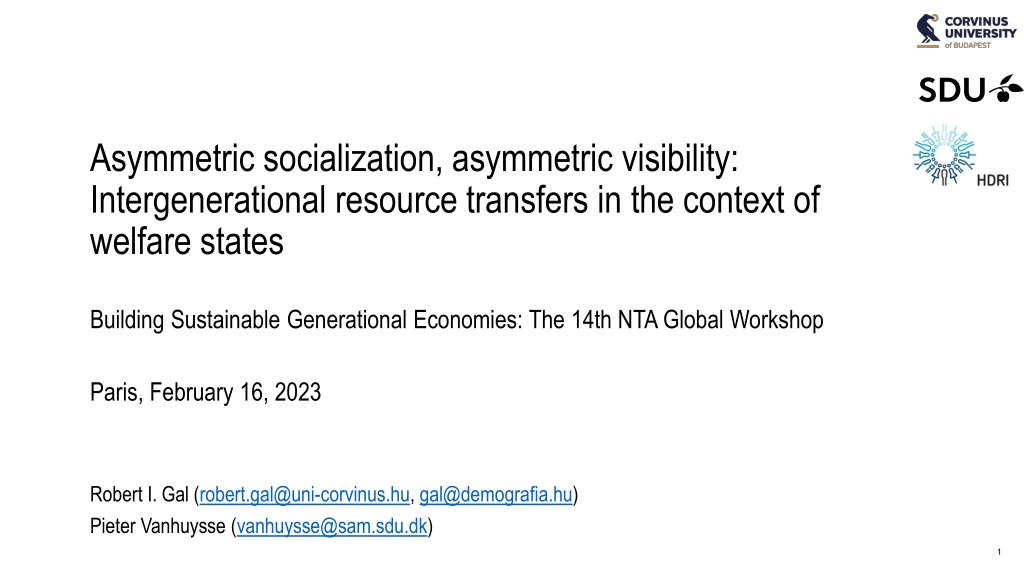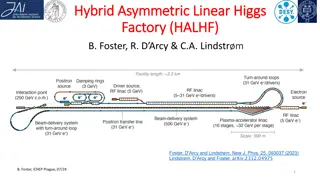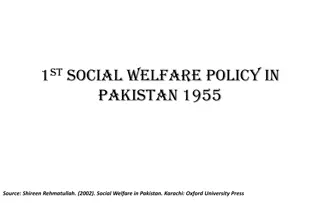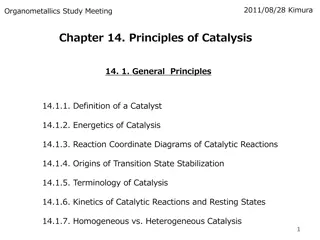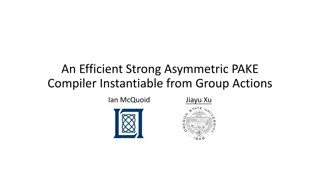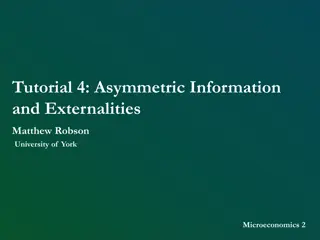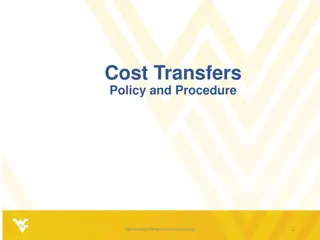Asymmetric Socialization and Resource Transfers in Welfare States
Exploring intergenerational resource transfers in the context of welfare states, this study examines three main channels: families, the government, and markets. It delves into different institutional arrangements governing asset-based reallocations, public transfers, and familial transfers. The levels of formality in these transfers impact visibility and socialization among age groups.
Download Presentation

Please find below an Image/Link to download the presentation.
The content on the website is provided AS IS for your information and personal use only. It may not be sold, licensed, or shared on other websites without obtaining consent from the author. Download presentation by click this link. If you encounter any issues during the download, it is possible that the publisher has removed the file from their server.
E N D
Presentation Transcript
Asymmetric socialization, asymmetric visibility: Intergenerational resource transfers in the context of welfare states Building Sustainable Generational Economies: The 14th NTA Global Workshop Paris, February 16, 2023 Robert I. Gal (robert.gal@uni-corvinus.hu, gal@demografia.hu) Pieter Vanhuysse (vanhuysse@sam.sdu.dk) 1
Introduction: The three main channels of inter-age reallocations There are three main channels of inter-age resource reallocations: families, the government, and markets, such as capital/property markets 150 100 The government provides pure public goods; the rest of the government as an inter-age reallocator is the welfare state 50 The emphasis is put on the word channel: neither government nor markets are actors 0 0 10 20 30 40 50 60 70 80 90+ -50 They are intermediaries among people of different age (and, to a much smaller extent, among people of different social status) -100 net public transfers net private transfers ABR LCD/LCS Source: own calculation based on data of selected European countries from the global database, www.ntaccounts.org. Vertical axis: Per capita values in percent of the per capita labor income of the cohort age 30-49. Horizontal axis: period age. 2
Governance, property rights, eligibilities The three primary forms of inter-age reallocations operate under very different institutional arrangements Asset-based reallocations are legal claims and obligations governed by explicit contracts and protected (or not) by property rights and the legal system Public transfers are less well-defined eligibilities and obligations governed by implicit contracts and protected (or not) by political force Protection by political force can be as strong or even stronger as protection by property rights and explicit contracts, but they are not specified so accurately Familial transfers are loosely defined eligibilities and obligations governed by habits and social norms (implicit contracts) 3
Asymmetric socialization, asymmetric visibility The levels of formality do not coincide with any quality levels; it is not that one is better because it is more formalized than the other But it affects how much we see of the various forms of inter-age transfers Asset-based reallocations and public transfers connect large groups of people who do not necessarily know each other In contrast, familial transfers connect small groups whose members are related Large-group arrangements imply administration and book-keeping; such arrangements leave an information trace and are (relatively) easy to collect data about Familial transfers are not documented; the parties involved usually cannot tell the value of such transfers Asset-based reallocations and public transfers are more visible for the statistical system The curse of high-quality data: in dim light, we see the whole picture but only vaguely; once a part of the image is enlighted we see the details but lose sight beyond 4
Shining a wider light: some pieces of received wisdom revisited NTA helps shine a wider light and incorporate formerly invisible segments of social reality In this wider light, several deeply rooted convictions of social policy analysis appear to be unfunded (Only) two stories (because of the time limits): The welfare state is a luxury. It charges high taxes on labour and undermines competitiveness Pro-elderly bias. The primary beneficiaries of social expenditures are older people: the creeping gerontocracy, grey panthers, silver power 5
The welfare state is a luxury (Vanhuysse and Gal, forthcoming) Net public transfers paid by people in working age: Sweden (2010) and Taiwan (2015) Source: Vanhuysse and G l (forthcoming). Source of raw data: Sweden: Istenic et al. (2016), Taiwan: Tung and Lai. The Swedish welfare state loads a heavy burden on net taxpayers; it makes labor expensive; and it undermines the economy. Or so it seems 6
Contd. Net public and familial/private transfers paid by people in working age: Sweden (2010) and Taiwan (2015) Source: As on the previous slide. Swedish labour is made expensive by taxes; Taiwanese labour is made expensive by the private transfers provided by working-age children to their old parents If private transfers that remain unobserved in national accounts are included, the Swedish welfare state is not expensive but visible 7
Pro-elderly bias (Gal, Vanhuysse and Vargha, 2018) The age distribution of net public transfers in selected European countries older persons receive more public transfers on average than children 150 100 currently older generations receive more than in past decades 50 the elderly/children public transfer ratio has been increasing 0 0 10 20 30 40 50 60 70 80 90+ -50 -100 net public transfers Source: based on Gal, Vanhuysse and Vargha, (2018); raw data from the global NTA database, www.ntaccounts.org. 8
Contd. The age distribution of net public and familial/private transfers in selected European countries (around 2010) The pro-elderly bias of public transfers is mostly compensated for if familial transfers are added 150 100 50 0 0 10 20 30 40 50 60 70 80 90+ -50 -100 net public transfers net private transfers Source: as on the previous chart. 9
Contd. The age distribution of net public familial/private and time transfers in selected European countries (around 2010) and if the value of the transfer of goods and services produced by unpaid domestic labour completes the picture, the bias changes sign 150 100 50 Europe provides many more transfers to children than to older people if the invisible transfers are also taken into account 0 0 10 20 30 40 50 60 70 80 90+ -50 -100 net public transfers net private transfers net time transfers Source: as on the previous chart. 10
The age-asymmetry in visibility Source: as on the previous chart. The pro-elderly bias is a story of the so far, pre-NTA/NTTA visible world NTA/NTTA shines a wider light; it largely expands the borders of the (statistically) visible world In this new light, many pieces of established knowledge have to be re-evaluated; here we discussed two such pieces 11
